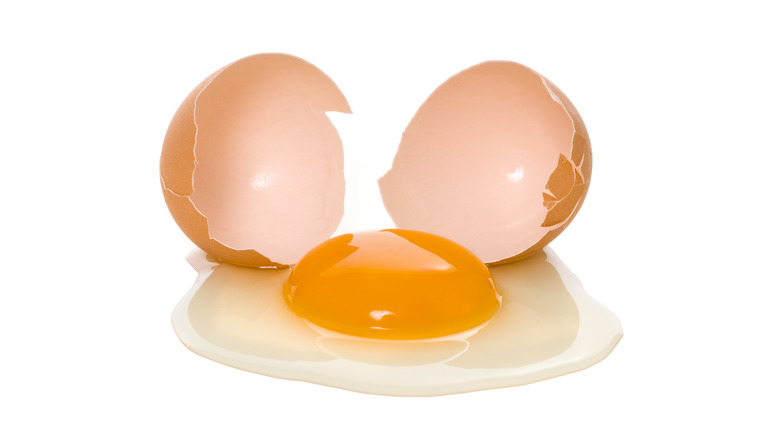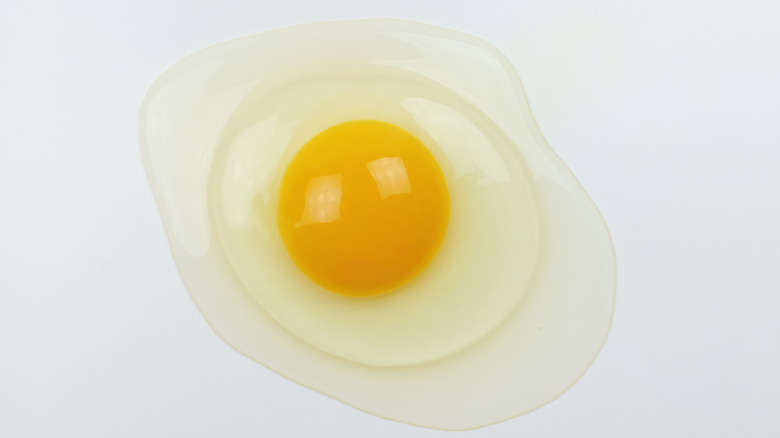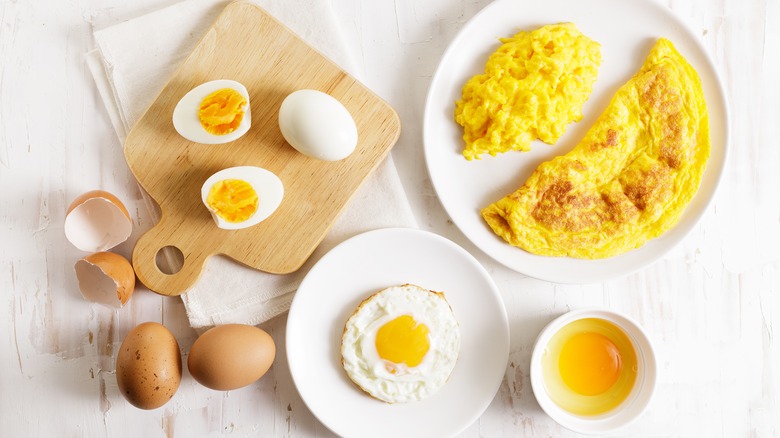The Inner And Outer Whites Of An Egg, Explained
When it comes to eggs, many people consider that the incredibly versatile ingredient contains two parts when cracked open: the white and the yolk. The yolk is the richer of the two, containing most of the egg's fat and calories while the white is a great source of lean protein. Perhaps you have also noticed, though, that when you break an egg open and it lays in a pan or a bowl, there are two noticeable layers of egg white; these are the inner and outer layers.
The inner layer is what the yolk is suspended on. It is noticeably thicker and appears somewhat bubble-like, like a layer of thick gel cushioning the yolk. The outer layer of white is thinner and flatter and is the part that cooks the quickest when frying an egg. When hens lay eggs, the white isn't immediately separated into these two components. As the fresh egg cools, the white separates into these two layers, which play vital roles in protecting the yolk or embryo — which, for eggs that are meant to be consumed, remain unfertilized. Together, both parts of the white make up about 60 percent of the egg's weight.
Egg white layers are meant to protect the yolk
The thinner, outer layer of an egg white lies closest to the egg shell. It is meant to be a filter, preventing any bacteria that comes in through the pores of the eggshell from penetrating the yolk. The inner layer is also meant to protect the yolk, but it is firmer, functioning as a cushion. This part of the egg white is 90 percent water, which is obvious if you pierce the inner white; it quickly spreads across your pan if you are frying your eggs.
Both the inner and outer layers of egg whites are partially made of keratin, the protein that is found in human hair, skin, and nails. Eating eggs is a great way to boost the body's keratin, supporting the health of these body parts. Both layers are clear and translucent; however, if you ever crack an egg open and notice that the thicker inner layer is a little cloudy, don't panic. This is actually an indication of the egg's freshness. Very fresh eggs will contain an inner white that is somewhat opaque. These are the best ones to use for soufflés, mousses, and merengues, as they will hold their structure better. If you're not sure how fresh your eggs are, try gently dropping them into a glass of water. The freshest ones will sink to the bottom of the glass. You can also keep your eggs fresher for longer by storing them upside down.
Eggs are much more than whites and yolks
Just like there's more to egg whites than meets the eye, there are more parts of the egg you likely haven't heard of. The vitelline membrane is an extremely thin, glossy layer that coats the egg yolk and keeps it from seeping out of its spherical shape. The fresher the egg, the stronger the membrane will be. Without it, you would say goodbye to any type of cooked eggs other than scrambled, as the structure of the egg inside the shell would be perpetually melded together.
The chalazae of an egg are white, string-like elements that appear to be directly attached to an egg's yolk. They are most apparent in fresh eggs, dissipating over time. They basically exist to keep the yolk intact and stabilized, which is especially important for fertilized eggs. The chalazae are completely edible, and you probably won't even notice them once you scramble or cook your eggs.
Eggs also contain shell membranes, air cells, and germinal discs, making what many consider a simple, straightforward ingredient something altogether fascinating and a superbly, naturally-protected edible element ... not to mention completely delicious.



